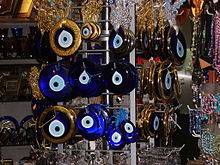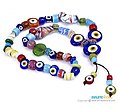| Revision as of 16:05, 18 October 2023 editDukeBravo (talk | contribs)30 editsmNo edit summaryTags: Visual edit Mobile edit Mobile web edit← Previous edit | Latest revision as of 14:49, 5 January 2025 edit undo2a02:1406:45:a1bc:ac97:dc37:3760:937f (talk)No edit summaryTags: Mobile edit Mobile web edit | ||
| (27 intermediate revisions by 19 users not shown) | |||
| Line 1: | Line 1: | ||
| {{short description|Eye-shaped amulet believed to protect against the evil eye}} | {{short description|Eye-shaped amulet believed to protect against the evil eye}} | ||
| ] | ] | ||
| ] – for sale in a shop.]] | |||
| ]) sold in a shop in ], Boston, Massachusetts, USA. Note the various modifications to the simple traditional form, such as setting the nazar into butterflies or Christian imagery.]] | |||
| ⚫ | An '''eye bead''' or '''naẓar''' (from ] {{wikt-lang|ar|نَظَر}} {{IPA|ar|ˈnaðˤar|}}, meaning 'sight', 'surveillance', 'attention', and other related concepts) is an eye-shaped ] believed by many to protect against the ]. The term is also used in ], ], ], ], ], ], ], ], ], ] and other languages.<ref name="Khan2006">{{cite book|last=Khan|first=Abdul Jamil|title=Urdu/Hindi: An Artificial Divide: African Heritage, Mesopotamian Roots, Indian Culture & British Colonialism|year=2006 |publisher=Algora Publishing |language=en|isbn=9780875864389|page=138|quote=Arabic verbs have generated an enormous number of words for Urdu/Hindi as well as Persian. ... The word ''nazar'', meaning eye, or sight, is part of the cultural idiom -- <nazar lag jana>, meaning 'evil eye's effect,' and is used in the whole subcontinent.}}</ref> In Turkey, it is known by the name '''{{transl|tr|nazar boncuğu}}'''<ref name="Williams">Williams, Victoria (2016). ''Celebrating Life Customs Around the World: From Baby Showers to Funerlan'', p.344. ABC-CLIO. {{ISBN|9781440836596}}. "nazar boncugu".</ref> (the latter word being a derivative of {{lang|tr|boncuk}}, "bead" in Turkic, and the former borrowed from Arabic), in Greece it is known as '''{{transl|el|máti}}''' ({{wikt-lang|el|μάτι}}, 'eye'). In ], it is called a '''{{transl|fa|cheshm nazar}}''' ({{langx|fa|چشم نظر}}) or '''{{transl|fa|nazar qurbāni}}''' ({{lang|fa|نظرقربانی}}).<ref>M. Moin: ''A Persian Dictionary, 3rd edition'', p. 4752 (in Persian).</ref> In India and Pakistan, the Hindi-Urdu slogan '']'' ({{wikt-lang|fa|چشم بدور}}, ' eye keep away') is used to ward off the evil eye.<ref>{{cite book|title=South Asian Cinema, Volume 1, Issue 1|url=https://books.google.com/books?id=0eVkAAAAMAAJ|year=2001|publisher=South Asian Cinema Foundation|language=en|page=61}}</ref> In the Indian subcontinent, the phrase ''nazar lag gai'' is used to indicate that one has been affected by the evil eye.<ref>{{cite journal|author1=Mehmet Kaan Kaya, Arun D Singh, Harminder S Dua|date=22 May 2009|title=Nazar boncugu—blue glass Evil Eye bead|url=https://bjo.bmj.com/content/93/6/707|journal=]|language=en|volume=93|issue=707|access-date=13 May 2019|quote=The phrases “Nazar lag gai” (affected by the Evil Eye) and “Nazar utarna” (removing the effects of Evil Eye) are common in Hindu culture.}}</ref><ref>Fallon, S.W. (1879). '''', p.1164. Lazarus. {{pre-ISBN}}. "''nazar lagānā'', v. a. To cast an evil eye upon; to regard with evil intent. [by an evil eye.<br/>''nazar lagnā, yā khānā'', v. n. To be influenced"</ref><ref>Clark-Decès, Isabelle; ed. (2011). ''A Companion to the Anthropology of India'', p.228. Wiley. {{ISBN|9781405198929}}. "nazar lagana".</ref> | ||
| ⚫ | |||
| It is commonly believed that the evil eye can be given in the guise of a compliment, signifying its connection to the destructive power of envy (for one's wealth, beauty etc.). Amulets such as the nazar are used in accordance with common sayings such as "an eye for an eye", where another eye can be used to protect the recipient of the malefic gaze.<ref>{{Cite book|title=The evil eye: a casebook|last=Dundes |first=Alan |date=1992 |publisher=University of Wisconsin Press |isbn=0-299-13334-6|oclc=863469680}}</ref> The evil eye causes its victim to become unwell the next day, unless a protective phrase such as "with the will of God" ('']'' in Arabic) or “ May Allah Bless You” (Alhumma Barik) is recited.<ref name="Giger2016">{{cite book|last=Giger|first=Joyce Newman|title=Transcultural Nursing|date=29 January 2016|publisher=Elsevier Health Sciences|language=en|isbn=9780323400046|page=351}}</ref> Among adherents of Hinduism in South Asia, when a mother observes that her child is being excessively complimented, it is common for them to attempt to neutralize the effects of the evil eye (''nazar utarna'') by "holding red chilies in one hand and circling the child's head a few times, then burning the chilies."<ref name="Shankar2014">{{cite book|last=Shankar|first=Vijay N.|title=Shadow Boxing with the Gods|date=20 August 2014|publisher=Leadstart Publishing |language=en|isbn=9789381836804|page=43}}</ref><ref name="Valsiner2000">{{cite book|last=Valsiner|first=Jaan|title=Culture and Human Development|date=2 February 2000|publisher=SAGE Publications|language=en |isbn=9780761956846|page=182|quote=In Rajastan (India) the treatment of the 'evil eye' includes seven red chilis and some salt circled over the head of the sick child before these are thrown into the hearth.}}</ref> | |||
| It originated in ]{{citation needed|date=November 2022}} and was first brought to Mediterranean countries through trade.{{citation needed|date=November 2022}} | |||
| The nazar was added to ] as {{unichar|1F9FF|Nazar Amulet}} in 2018.<ref>{{cite web|url=https://emojipedia.org/nazar-amulet/|title=🧿 Nazar Amulet Emoji|website=]}}</ref> | The nazar was added to ] as {{unichar|1F9FF|Nazar Amulet}} in 2018.<ref>{{cite web|url=https://emojipedia.org/nazar-amulet/|title=🧿 Nazar Amulet Emoji|website=]}}</ref> | ||
| Line 19: | Line 14: | ||
| == Eye bead == | == Eye bead == | ||
| ] | ] | ||
| The Turkish |
The Turkish {{lang | tr | boncuk}} (sometimes called a {{lang | tr | göz boncuğu}} or '''eye bead''') is a glass bead characterized by a blue glass field with a blue white and black dot superimposed on a white or yellow center. A design of great antiquity, the blue bead has gained importance as an item of popular ] in modern Turkey. The bead probably{{original research inline|date=July 2024}} originated in the ] and is associated{{citation needed|date=July 2024}} with the ]. Written documentation and extant beads date from as early as the 16th century BC. Glass beads were made and widely used throughout the ancient world: from ] to ], from ] to ancient ], from ] to ], and throughout the ].{{Citation needed|date=September 2022}} | ||
| ] | |||
| "The mythology behind it says that if one of the beads breaks down, it means a very strong ''nazar'' has hit you |
"The mythology behind it says that if one of the beads breaks down, it means a very strong ''nazar'' has hit you, and the bead stored it all up and broke down in order to protect the carrying person."<ref> | ||
| TurkishClass101.com (2017) ''''. Innovative Language Learning.</ref> | |||
| == Gallery == | == Gallery == | ||
| <gallery> | <gallery> | ||
| ] | |||
| File:Nazar Amulet in Turkey.jpg|Nazar Amulet | File:Nazar Amulet in Turkey.jpg|Nazar Amulet | ||
| File:Evil Eye Beads.jpg|Turkish Nazar Eye Beads | File:Evil Eye Beads.jpg|Turkish Nazar Eye Beads | ||
| File:Nazar.jpg|Nazar-inspired sculpture in the Netherlands. | File:Nazar.jpg|Nazar-inspired sculpture in the ]. | ||
| File:Evil eye.jpg|Nazar evil eye charms. | File:Evil eye.jpg|Nazar evil eye charms. | ||
| File:Cheshm-Nazar.JPG|A Persian ''cheshm nazar''. | File:Cheshm-Nazar.JPG|A Persian ''cheshm nazar''. | ||
| Line 58: | Line 53: | ||
| * {{commons category-inline|Nazar amulets}} | * {{commons category-inline|Nazar amulets}} | ||
| * {{cite web |title=Nazar Amulet – Blue Color Wards Off The Evil Eye According To Ancient Belief |url=http://www.ancientpages.com/2018/03/13/nazar-amulet-blue-color-wards-off-the-evil-eye-according-to-ancient-belief/ |website=Ancient Pages |access-date=13 July 2021 |date=12 March 2018}} | * {{cite web |title=Nazar Amulet – Blue Color Wards Off The Evil Eye According To Ancient Belief |url=http://www.ancientpages.com/2018/03/13/nazar-amulet-blue-color-wards-off-the-evil-eye-according-to-ancient-belief/ |website=Ancient Pages |access-date=13 July 2021 |date=12 March 2018}} | ||
| {{Amulets and Talismans}} | {{Amulets and Talismans}} | ||
Latest revision as of 14:49, 5 January 2025
Eye-shaped amulet believed to protect against the evil eye

An eye bead or naẓar (from Arabic نَظَر [ˈnaðˤar], meaning 'sight', 'surveillance', 'attention', and other related concepts) is an eye-shaped amulet believed by many to protect against the evil eye. The term is also used in Azerbaijani, Bengali, Hebrew, Hindi–Urdu, Kurdish, Pashto, Persian, Punjabi, Turkish, Greek and other languages. In Turkey, it is known by the name nazar boncuğu (the latter word being a derivative of boncuk, "bead" in Turkic, and the former borrowed from Arabic), in Greece it is known as máti (μάτι, 'eye'). In Persian and Afghan folklore, it is called a cheshm nazar (Persian: چشم نظر) or nazar qurbāni (نظرقربانی). In India and Pakistan, the Hindi-Urdu slogan chashm-e-baddoor (چشم بدور, ' eye keep away') is used to ward off the evil eye. In the Indian subcontinent, the phrase nazar lag gai is used to indicate that one has been affected by the evil eye.
The nazar was added to Unicode as U+1F9FF 🧿 NAZAR AMULET in 2018.
Amulet
A typical nazar is made of handmade glass featuring concentric circles or teardrop shapes in dark blue, white, light blue and black, occasionally with a yellow/gold edge. "The bead is made of a mixture of molten glass, iron, copper, water, and salt, ingredients that are thought to shield people from evil."
"According to Turkish belief, blue acts as a shield against evil and even absorbs negativity." In the Middle East and the Mediterranean, "blue eyes are relatively rare, so the ancients believed that people with light eyes, particularly blue eyes, could curse you with just one look. This belief is so ancient, even the Assyrians had turquoise and blue-eye amulets."
Eye bead

The Turkish boncuk (sometimes called a göz boncuğu or eye bead) is a glass bead characterized by a blue glass field with a blue white and black dot superimposed on a white or yellow center. A design of great antiquity, the blue bead has gained importance as an item of popular culture in modern Turkey. The bead probably originated in the Mediterranean and is associated with the development of glass-making. Written documentation and extant beads date from as early as the 16th century BC. Glass beads were made and widely used throughout the ancient world: from Mesopotamia to Egypt, from Carthage to ancient Greece, from Phoenicia to Persia, and throughout the Roman imperial period.

"The mythology behind it says that if one of the beads breaks down, it means a very strong nazar has hit you, and the bead stored it all up and broke down in order to protect the carrying person."
Gallery
-
 Nazar Amulet
Nazar Amulet
-
 Turkish Nazar Eye Beads
Turkish Nazar Eye Beads
-
 Nazar-inspired sculpture in the Netherlands.
Nazar-inspired sculpture in the Netherlands.
-
 Nazar evil eye charms.
Nazar evil eye charms.
-
A Persian cheshm nazar.
-
 Nazar on a newborn baby's hospital room door in Turkey.
Nazar on a newborn baby's hospital room door in Turkey.
-
 A selection of Jewish amulets, an ayin mazal is visible next to the hamsa.
A selection of Jewish amulets, an ayin mazal is visible next to the hamsa.
See also
- Eye of Providence
- God's eye
- Evil eye
- Darśana
- Eyespot (mimicry)
- Görece, Menderes
- Hamsa
- Namkha
- Nazar battu
- Mezuzah
- Skandola
- Ta'wiz
References
- Khan, Abdul Jamil (2006). Urdu/Hindi: An Artificial Divide: African Heritage, Mesopotamian Roots, Indian Culture & British Colonialism. Algora Publishing. p. 138. ISBN 9780875864389.
Arabic verbs have generated an enormous number of words for Urdu/Hindi as well as Persian. ... The word nazar, meaning eye, or sight, is part of the cultural idiom -- <nazar lag jana>, meaning 'evil eye's effect,' and is used in the whole subcontinent.
- ^ Williams, Victoria (2016). Celebrating Life Customs Around the World: From Baby Showers to Funerlan, p.344. ABC-CLIO. ISBN 9781440836596. "nazar boncugu".
- M. Moin: A Persian Dictionary, 3rd edition, p. 4752 (in Persian).
- South Asian Cinema, Volume 1, Issue 1. South Asian Cinema Foundation. 2001. p. 61.
- Mehmet Kaan Kaya, Arun D Singh, Harminder S Dua (22 May 2009). "Nazar boncugu—blue glass Evil Eye bead". British Journal of Ophthalmology. 93 (707). Retrieved 13 May 2019.
The phrases "Nazar lag gai" (affected by the Evil Eye) and "Nazar utarna" (removing the effects of Evil Eye) are common in Hindu culture.
{{cite journal}}: CS1 maint: multiple names: authors list (link) - Fallon, S.W. (1879). A New Hindustani-English Dictionary, p.1164. Lazarus. . "nazar lagānā, v. a. To cast an evil eye upon; to regard with evil intent. [by an evil eye.
nazar lagnā, yā khānā, v. n. To be influenced" - Clark-Decès, Isabelle; ed. (2011). A Companion to the Anthropology of India, p.228. Wiley. ISBN 9781405198929. "nazar lagana".
- "🧿 Nazar Amulet Emoji". Emojipedia.
- Lonely Planet Middle East. Lonely Planet; 6 edition, 2009, p. 559.
- Sinclair, H. R. (2022). A Writer's Guide to Color. H. R. Sinclair.
- Yablon, Alys R. (2015). Field Guide to Luck. Quirk Books. ISBN 9781594748363.
- Martinson, Barbara; DeLong, Marilyn; eds. (2012). Color and Design. Bloomsbury. ISBN 9781847889539.
- Darke, Diana (2014). Eastern Turkey, p.31. Bradt Travel Guides. ISBN 9781841624907. The evil eye, "generally takes the form of a blue-eye, because foreigners, were more likely to have blue eyes, were also more likely to stare, thereby unwittingly contravening local convention, and, by admiring the children or possessions of their hosts, accidentally casting the evil eye upon them."
- Lynn, Heather (2019). Evil Archaeology, p.167. Red Wheel Weiser. ISBN 9781633411272.
- TurkishClass101.com (2017) Learn Turkish - Level 2: Absolute Beginner. Innovative Language Learning.
Sources
- Ronald T. Marchese (2005). The Fabric of Life: Cultural Transformations in Turkish Society. pp. 103–107.
External links
 Media related to Nazar amulets at Wikimedia Commons
Media related to Nazar amulets at Wikimedia Commons- "Nazar Amulet – Blue Color Wards Off The Evil Eye According To Ancient Belief". Ancient Pages. 12 March 2018. Retrieved 13 July 2021.